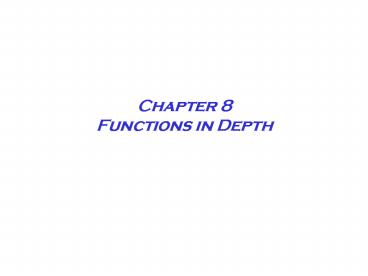Chapter%208%20Functions%20in%20Depth - PowerPoint PPT Presentation
Title:
Chapter%208%20Functions%20in%20Depth
Description:
Chapter 8. Functions eliminate the need for duplicate statements within a program. ... Chapter 8. A function prototype is a model of the interface to the function. ... – PowerPoint PPT presentation
Number of Views:44
Avg rating:3.0/5.0
Title: Chapter%208%20Functions%20in%20Depth
1
Chapter 8Functions in Depth
2
Chapter 8
- A programmer-defined function is a block of
statements, or a subprogram, that is written to
perform a specific task required by you, the
programmer.
3
Chapter 8
- Functions eliminate the need for duplicate
statements within a program. Given a task to be
performed more than once, the statements are
written just once for the function. Then, the
function is called each time the task must be
performed. - Functions make the program easier to design,
since the program behaviors (algorithms) are
modularized as individual functions, whose
combined execution solves the problem at hand.
4
Chapter 8
- Functions make the program easier to code and
test, since you can concentrate on a single
function at a time, rather than one big main()
function. - Functions allow for software reusability, where
existing functions can be reused to create new
programs. - Functions make the program more clear and
readable, thus making the program easier to
maintain.
5
Chapter 8
- Functions provide the basis for structured as
well as object-oriented programming
6
Chapter 8
- A non-void function is a function that, when
called, returns a single value to the calling
program.
7
Chapter 8
- Non-void Function Format
- //FUNCTION HEADER
- return data type function name (parameter list)
- //BEGIN FUNCTION STATEMENT BLOCK
- //LOCAL VARS
- local variables should go here
- //FUNCTION STATEMENTS or BODY
- statement 1
- statement 2
- statement n
- return value
- //END FUNCTION STATEMENT BLOCK
8
Chapter 8
- The function header forms the interface between
the calling program and the function.
9
Chapter 8
- The function header consists of a return type, if
any, the function name, and a parameter listing.
10
Chapter 8
- The value returned by a non-void function
replaces the function name wherever the name is
used in the calling program.Examples - result cube(a)
- cout ltlt cube(a)
- solution 2 ? cube(a) 5
11
Chapter 8
- Arguments are values/variables used within the
function call, and parameters are variables used
within the function header that receive the
argument values.
12
Chapter 8
- A void function is a function that returns
multiple values or performs some specific task,
rather than returning a single value to the
calling program.
13
Chapter 8
- When calling a void function, simply list the
function name and required arguments as a single
statement within your program. Do not call a void
function with an assignment operator or cout
object as you do non-void functions.Example
displayHeader()
14
Chapter 8
- A value parameter provides for one-way
communication of data from the calling program to
the function. - A reference parameter provides two-way
communication of data between the calling program
and function.
15
Chapter 8
- Locating Functionsin a Program
16
Chapter 8
- A function prototype is a model of the interface
to the function. - Simply copy/paste the function header and add a
semicolon to code the prototype. - Locate your function prototypes after the
preprocessor directives and before main().
17
Chapter 8
- A default parameter is a function parameter that
is assigned a default value in either the
function prototype or the function header, but
not both. Exampleint volume(int length, int
width 5, int height 2)
18
Chapter 8
- An overloaded function exhibits different
behavior with a different number of arguments or
argument data types. Example - int calculateArea(int)
- int calculateArea(int, int)
- double calculateArea(double)
19
Chapter 8
- A local variable is a variable that is defined
within a specific block of code, such as a
function. - The scope of a variable refers to the largest
block in which a given variable is accessible. - Always define your variables as locally as
possible within a given function block. If
variables need to be shared among functions, pass
them.
20
Chapter 8
- Recursion is a process whereby an operation calls
and clones itself until a terminating condition
is reached. - Examples of recursive operations include compound
interest calculation, summation, and factorial,
just to mention a few.
21
Chapter 8
- Calculating a Monthly Compounded Bank Balance
using Recursion - If n is 0 balance(n) deposit
- Else
- balance(n) (1rate/12/100)?
balance(n1)(Where n is the month for which the
balance must be determined.)
22
Chapter 8
- A recursive function must always reach a
terminating condition. If it does not, the
function will keep calling itself forever,
resulting in a memory overflow run-time error.
23
Chapter 8
- double balance(double deposit, int month, double
rate) - if (month 0)
- return deposit
- else
- return (1 rate / 12 / 100)
balance(deposit,month 1,rate) - //END balance()
24
Chapter 8
25
Chapter 8
- If n is 1
- sum(n) 1
- Else
- sum(n) n sum (n 1)
26
Chapter 8
- int sum(int n)
- if (n 1)
- return 1
- else
- return n sum(n ? 1)
- //END sum()
27
Chapter 8
- int sum(int n)
- int subTotal 0 //SUM SUBTOTAL
- for (int count 1 count lt n count)
- subTotal subTotal count
- return subTotal
- //END sum()

